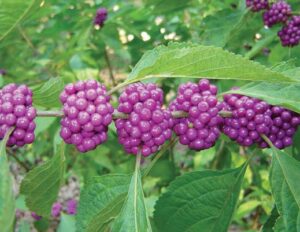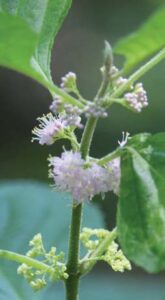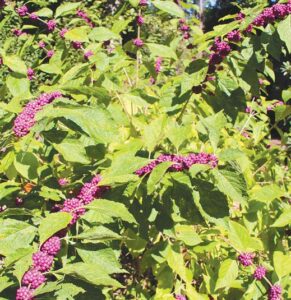Autumn, is American beautyberries, Callicarpa americana, season of fame. The genus Callicarpa is Greek meaning beautiful fruit. When mature, the southeastern, North American, native, deciduous shrub stands 4-8’ high with an open and graceful arching growth habit and light green elliptical serrated foliage. Inconspicuous clusters of small white or pinkish lavender flowers draw pollinators in spring before yielding to clusters of green berries in summer. By September rich purple berries wrap around the stems like baubles on beaded bracelets or fruit clinging to shish kabob.
The upright multi-trunked shrub is found growing under canopy pine, oak, hickory, maple trees, understory sassafras, flowering dogwood, and red buckeye trees. In the wild, beautyberries are often found growing with other native shrubs like sweet shrub, hearts-a-bustin, and wax myrtle. USC’s Belser Arboretum has a large display of fruits of fall including beautyberries.
The American beautyberry has a slew of common names—French mulberry, Spanish mulberry, beautyberry, dwarf mulberry, sow berry, and sour berry. The shrub is not related to mulberries but rather to mint family members.
Come fall when the fruit appears, gardeners, florists, passersby, children, and wildlife take notice. Floral arrangers snip the bejeweled branches for indoor dry displays. Native habitat and woodland gardeners plant masses of beautyberry.
The plants attract game birds like the bobwhite quail that come for food and cover. Over 40 species of songbirds, including American robin, northern cardinal, brown thrashers, mockingbird, purple finch, and eastern towhee, consume the berries. Migrating catbirds, orioles, robins, and thrushes depend on beautyberries for sustenance.
Small mammals like armadillo, squirrels, opossum, raccoon, gray fox, and some rodents devour the berries. too. Deer browse on the leaves in summer and fruit in fall. The shrub is host to the spring azure butterfly and snowberry clearwing moth.
Although wildlife disperses seed throughout its range, the shrub self-sows, too. Gardeners propagate from seed and softwood cuttings in spring and summer.
Beautyberries bear more fruit if several are planted together.
The shrub requires little maintenance, has no major pests or diseases, and is resistant to drought and fire. It thrives in loam, sand, and clay soils (pH from 4.8- 7) with plenty of organic matter like its native woodland habitat. Beautyberry is used in bird gardens, rain gardens, children’s gardens, pollinator gardens, and surface mine reclamation.
Native Americans used root and leaf tea in sweat baths for rheumatism, fevers, and malaria. They made root and berry tea for colic.
What do ecologists and horticulturists think about the shrub? Doug Tallamy and Rick Darke extol the shrub’s ecological and landscape functions: “pollinator plant, food for birds and caterpillars, summer flowers, and fall foliage color and fruit.”
Steve Bender, coauthor of Passalong Plants claims, “When the berries are ripe, this shrub is hard to resist.”
Thomas Jefferson’s plant diplomacy included sending beautyberry to estates in France from Monticello in the 1780s.
If your local garden center doesn’t stock native beautyberry, Woodlanders in Aiken is where I purchased one shrub many years ago. Through self-seeding and bird droppings, I now have eight purple beautyberry shrubs and one white beautyberry from a wildlife visitor. Check out the Midlands Chapter of the South Carolina Native Plant Society for its upcoming fall sale at scnps.org/midlands-2.






Loading Comments